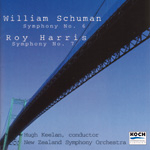This coupling interestingly mirrors the popular pairing of Roy Harris and William Schuman’s Third symphonies (most recently done by Leonard Bernstein with the New York Philharmonic on DG). As before, both composers’ works appear to play off each other, revealing their surface similarities and also their profound differences. Those who know Harris’ Third will find themselves on familiar ground in the Seventh, as it too is in one continuous movement (Koch’s tracking subdivides by tempo indications). Also like its predecessor, Harris’ argument constitutes a grand arc that begins with material of a searching, questioning nature and then proceeds through a series of dramatic permutations, brilliantly rendered in his uniquely-colored orchestral palette before resolving to an affirmative close. While in some ways the Seventh could seem a rehash of the Third, Harris’ thematic language actually has become more complex and his mode of expression more emphatic, though he still retains his trademark love for thrilling brass flourishes.
William Schuman’s Sixth also begins in an atmosphere of uncertainty, but it soon departs along its own path, utilizing a far more abrasive harmonic vocabulary–a style that would become increasingly pervasive in the composer’s work. Consequently, this piece requires greater concentration from the listener than its disc-mate. The layout of the Sixth also comprises one continuous span, though Schuman arranges it into sections (again with convenient tracking provided) that function as distinct movements. The music begins very slowly and progresses in tempo to a rapid Leggeramente section before coming to a dead stop for the central Adagio (featuring some rather undistinguished melodic material). Then it picks up for a brief “scherzo” and a powerful presto conclusion. Both symphonies had the distinction of premiere recordings by Eugene Ormandy and the Philadelphia Orchestra (classic versions available on Albany), but American conductor Hugh Keelan commands the full measure of these works and gets the New Zealand Symphony to play them with all the gusto and bravura of a home-grown band. No doubt Harris and Schuman would be thrilled by such powerful modern advocacy of their music, presented in Koch’s vivid and dynamic sound. [12/20/2001]
































